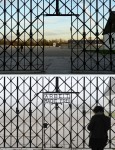 A wrought iron gate bearing the infamous Nazi slogan “Arbeit macht frei” stolen from the entrance to Dachau in 2014 was returned to the concentration camp memorial in a ceremony on Wednesday, Feb. 22th. The gate was stolen from the Dachau memorial on the night of November 1-2, 2014. It was found two years later rusting under a tarp in a parking lot in Ytre Arna outside Bergen, Norway. The thieves remain unknown.
A wrought iron gate bearing the infamous Nazi slogan “Arbeit macht frei” stolen from the entrance to Dachau in 2014 was returned to the concentration camp memorial in a ceremony on Wednesday, Feb. 22th. The gate was stolen from the Dachau memorial on the night of November 1-2, 2014. It was found two years later rusting under a tarp in a parking lot in Ytre Arna outside Bergen, Norway. The thieves remain unknown.
“This is a meaningful day for the memorial,” said Ludwig Spaenle, the Bavarian minister of cultural affairs. He called the theft of the gate an attack on a place of remembrance and said that the integrity of the memorial could now be “somewhat healed.”
Karl Freller, who heads the foundation responsible for the Dachau memorial, said he was “happy and grateful,” stating “now that we have the gate back we will not let it out of our sight.”
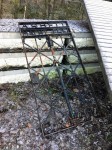 Dachau bears the repulsive distinction of being the first concentration camp established by the shiny new Nazi government on March 22nd, 1933, less than two months after Hitler’s ascension to the chancellorship of Germany. The former munitions factory was converted into a forced labour camp for political prisoners which at that time were the Communists and Social Democrats who opposed the Nazi Party. As soon as Hitler was appointed chancellor, he ordered the systematic persecution of his political rivals to consolidate his grip on power. Dachau became a death camp for the slaughter of Jews, homosexuals, Roma and anyone else they deemed inferior during the war, but of course they kept that “Works Sets You Free” sign (always a blatant lie since from day one none of those political prisoners could ever work their way to freedom), as if the purpose of the camp were labour, not mass-murder.
Dachau bears the repulsive distinction of being the first concentration camp established by the shiny new Nazi government on March 22nd, 1933, less than two months after Hitler’s ascension to the chancellorship of Germany. The former munitions factory was converted into a forced labour camp for political prisoners which at that time were the Communists and Social Democrats who opposed the Nazi Party. As soon as Hitler was appointed chancellor, he ordered the systematic persecution of his political rivals to consolidate his grip on power. Dachau became a death camp for the slaughter of Jews, homosexuals, Roma and anyone else they deemed inferior during the war, but of course they kept that “Works Sets You Free” sign (always a blatant lie since from day one none of those political prisoners could ever work their way to freedom), as if the purpose of the camp were labour, not mass-murder.
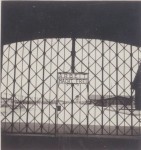 The Jourhaus, the entrance and exit to the prison camp, was built by prisoners by command of the SS in May and June of 1936. The SS ordered Communist political prisoner Karl Röder to make the “Arbeit macht frei” sign. The news stories about the theft, recovery and reinstallation all refer to the stolen gate as the “original,” in contrast to the replica that was put in its place in 2015 for ceremonies commemorating the 70th anniversary of the liberation of Dachau by the US Army on April 29th, 1945. In fact, the “Arbeit macht frei” sign in the stolen gate is not the original made by Röder.
The Jourhaus, the entrance and exit to the prison camp, was built by prisoners by command of the SS in May and June of 1936. The SS ordered Communist political prisoner Karl Röder to make the “Arbeit macht frei” sign. The news stories about the theft, recovery and reinstallation all refer to the stolen gate as the “original,” in contrast to the replica that was put in its place in 2015 for ceremonies commemorating the 70th anniversary of the liberation of Dachau by the US Army on April 29th, 1945. In fact, the “Arbeit macht frei” sign in the stolen gate is not the original made by Röder.
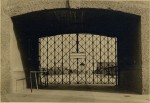 It’s not clear what happened to the original original. It was in place right after liberation. There’s an undated photograph of the gate taken by former political prisoner Franz Brückl that shows the sign in place. Researchers believe it was taken immediately after liberation. Another photograph, also unfortunately undated, but taken after Brückl’s shows the gate with the inscription removed. An exact replica was created from historical photographs and installed in the gate after the Dachau memorial opened in 1965. This is confirmed by a 1972 memorandum in the memorial’s archives which notes: “Reconstruction of the inscription removed from the iron gate, work is free.”
It’s not clear what happened to the original original. It was in place right after liberation. There’s an undated photograph of the gate taken by former political prisoner Franz Brückl that shows the sign in place. Researchers believe it was taken immediately after liberation. Another photograph, also unfortunately undated, but taken after Brückl’s shows the gate with the inscription removed. An exact replica was created from historical photographs and installed in the gate after the Dachau memorial opened in 1965. This is confirmed by a 1972 memorandum in the memorial’s archives which notes: “Reconstruction of the inscription removed from the iron gate, work is free.”
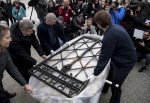 So the gate is original, but the sign is not. The symbolic significance of the gate and the most chilling words inscribed over a doorway since Dante’s Inferno remains undiminished, which is why it and the much larger Auschwitz sign were stolen in the first place.
So the gate is original, but the sign is not. The symbolic significance of the gate and the most chilling words inscribed over a doorway since Dante’s Inferno remains undiminished, which is why it and the much larger Auschwitz sign were stolen in the first place.
 The recovered gate is now being treated by conservators. It will go back on public display this April 29th, but will not be reinstalled in the Jourhaus. Instead, it will be on view in the Dachau concentration camp memorial museum. The 2015 replica will stay in place.
The recovered gate is now being treated by conservators. It will go back on public display this April 29th, but will not be reinstalled in the Jourhaus. Instead, it will be on view in the Dachau concentration camp memorial museum. The 2015 replica will stay in place.